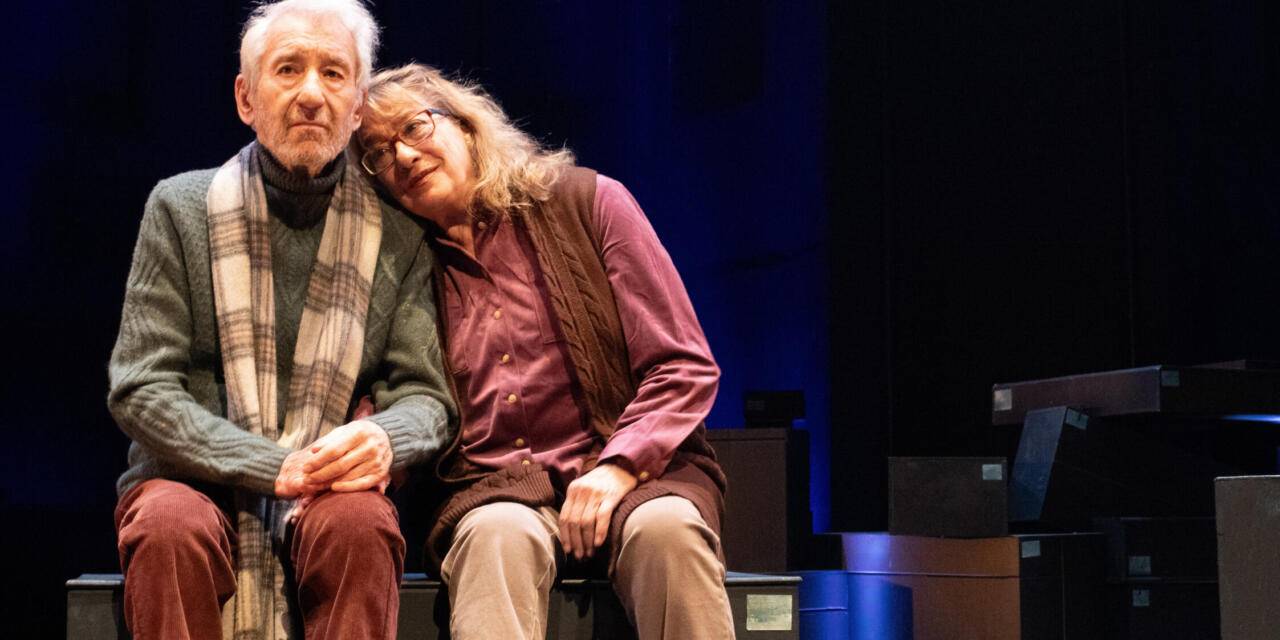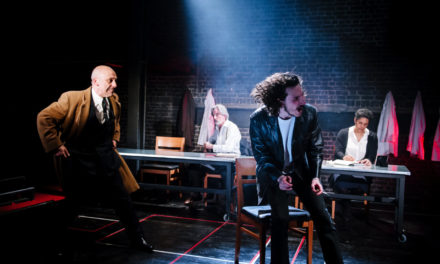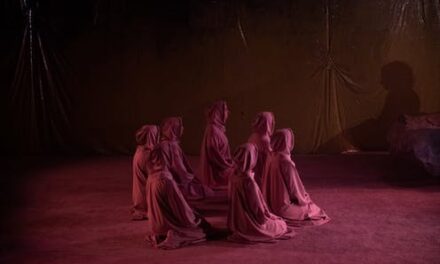Juan Mayorga might have been a crime writer in another life, he loves to set up complex, menacing conceits that explore behaviour on the fringes of criminality. What constitutes right? How far does context determine what is acceptable? La colección (The Collection) presented at Madrid’s Teatro de La Abadía, the theatre Mayorga now runs, is no exception. This is a piece about art and value, about what we own and why we own it. Mayorga directs his own play with a clinical precision in terms of language and word play. Alessio Meloni designs a set that accentuates the associations of this former church — one of Madrid’s most renowned venues which makes an appearance in Almodóvar’s 2021 film Parallel Mothers. High ceilings create the sense of a hallowed space. Tall shutters keep out the light that filters through the blurred stained-glass windows. Dark grey boxes and packing cases of different shapes and sizes populate a large room. Mayorga’s play is like the boxes that clutter the stage: a mystery to be unravelled, a Pandora’s Box to be opened again and again delivering multiple pleasures.
At the play’s opening, the shutters are closed methodically by Carlos (Ignacio Jiménez), manservant to two prominent collectors Héctor and Berna Pereira (José Sacristán and Ana Marzoa). They have invited another collector, Susana Gelman (Zaira Montes) — we assume she buys ‘art’ but it is never made clear — to their house. Héctor’s health is faltering and the couple are looking into what to do with the collection. They don’t want a buyer: they want an heir and have invited Susana to see if she is the “right” heir. The complicity between the couple is evident in their complicitous ease and their colour coordinated attire — both are dressed in shades of burnished rust, pale to mid brown and, in Héctor’s case, also olive green. They interrupt each other, finish each other’s sentences and whisper into each other’s ears. He is frailer than she is; he twitches and squints and sometimes forgets his train of thought, but he commands attention, tapping his glass for silence when he wants to speak. At first Berna stays close to Susana, as if observing her every move. Carlos, their “assistant”, sometimes sits at a distance, observing the proceedings; at other times he hovers behind Berna and Héctor. For all the clutter in the room, there is a sense of unease and discomfort, an edge that to the deals are being discussed. The opening scene has something of Bernard-Marie Koltès’ eerie landscapes — transactions that are never quite defined but that have significant implications on the ensuing action.
Hector doesn’t want the collection to go to the nation, fearing a civil servant may decide a piece is immoral and banish it to a basement. “We don’t trust the State. In any state” he observes. Berna wants to ensure the collection they have amassed passes to someone who will preserve it in its entirety: “the collection is more important than the pieces that make it up.” They know they don’t want it to be a collection for tourists: “We don’t want people who see it as a place for their free time” says Héctor. Berna insists that their only ambition is “to do justice to the pieces”.
The couple have done their homework on the clinical Susana, they know what she likes and what she buys. Zaira Montes’ Susana strides with a sense of entitlement. Her well cut trousers and elegant cream coat points to good taste; her designer trainers evoke stylistic comfort. Susana doesn’t do things by halves, grand gestures — she almost storms out twice like a petulant child — point to someone used to getting her own way. Héctor and Berna also know of her criminal past. They have been watching her for some time. Can she be sure that what they say they want is what they are actually planning. Berna is honest that she and Héctor like to argue – it helps them think, she alleges: “one sees what the other doesn’t see and defends it passionately”. Héctor once took up boxing to win Berna over and the suggestion of the space as a boxing ring points to possible casualties at the end of the night. Héctor boxes a fictional opponent with his fists — he may speak of blackouts and a physical deterioration but his visit to Susana during the night in tracksuit and trainers betrays an agile mind, a man still keen on intellectual banter.
Have the couple bought Susana there under false pretences? And is Susana also honest about what her intentions are? She has plans to purchase another collection from a certain Alberto – here presenting herself as an academic seeking to buy a bundle of letters for a research project. She wants Carlos, Héctor and Berna’s aide, to help her, pretending to be her husband Jaime giving an excuse for her absence: that she cannot be there because of a sick child. She is inpatient – she wants to secure both but may not be able to pull it off.
Mayorga gives little concrete exposition – just snippets of information that leave gaps for the audience to ponder: we can’t be sure what is true and what is myth, “Legends that include more legends” (in Héctor’s words) have grown up around the couple. Susana mentions the three different views of those who allege to have visited the collection: two coincide in referring to “a mosaic of concentric circles that they saw” from an elevated platform but a third has a different tale of what they saw. Is Héctor really blanking out as he claims? Is this what is prompting the couple’s decision? When Héctor visits Susana alone later that evening, is he being honest when he tells her she is still in time to leave and renounce the collector’s way of life? Berna, in her nocturnal visit to Susana in burnished orange pyjamas and a warm matching cardigan taunts her by stating “I don’t think we will give you the collection, which will be painful after you have seen it. You should leave before the night ends.” Berna plays a game: cleaning her glasses if to announce she needs to see more clearly, attentive to her phone which seems to bring her messages from an auction but keeping her distance.
There is greater proximity in the encounter between Héctor and Susana. When Berna walks away, Susana initially looks somewhat deflated, but she phones her husband with her impressions that Héctor and Berna’s collection is simply “a money-making machine”, speculating that she has been brought here to inflate the myths around the collection and by association its monetary worth. Indeed, when Héctor and Berna are alone at the end of the night, their playful conversation betrays that the couched invitation is a ploy they have employed with others. Susana also plays a game of emotional seduction in her individual pleas to both Héctor and Berna separately to see the collection with one of them.
The play juggles a number of reflections on collecting and collections. Héctor idealises what it has offered them: “It has protected us from that time dominated by money, speed and mirrors; that’s what fascinates everyone and what everyone aspires to”. Susana believes that everyone collects something. When pushed by Susana, Carlos acknowledges that he collects “Gestures. People’s gestures”. For Berna and Héctor collecting has become an obsession. Héctor maps how he funded the collection – selling certain pieces to buy others, anticipating what people will like. Berna delineates how they keep the pieces they are planning to sell on for profit separately. Berna defines their collection as something active and alive; each new piece enters into a complicitous relationship with parts of the collection and an antagonistic relationship with other parts of it. Berna presents a collector as someone who recognises their lack of importance: “the true collector is time”. Héctor too refers art as being “made by time”. Susana speaks of the importance of patience in collecting. Héctor acknowledges that the collection has driven them to do some unforgivable things, irreparable acts. Berna on the other hand sees the collection as something that has united them like nothing else. For Carlos what the couple see in the collection can’t be bought.
The dialogue spills over to consider literary writing. Héctor draws the analogy of a collection as a book written with the words of others. What is permissible in writing and collecting? Berna asks Susana a timely question as to whether she would exploit someone or do something unjust to improve her collection. Does she know what Susana is planning to do? Has Carlos confided in her? Susana enjoys a pretty much identical conversation with both Héctor and Berna, sitting close to them on a large trunk like box that also functions as a makeshift bed as she tries to get the upper hand in the games in which they are all embroiled.
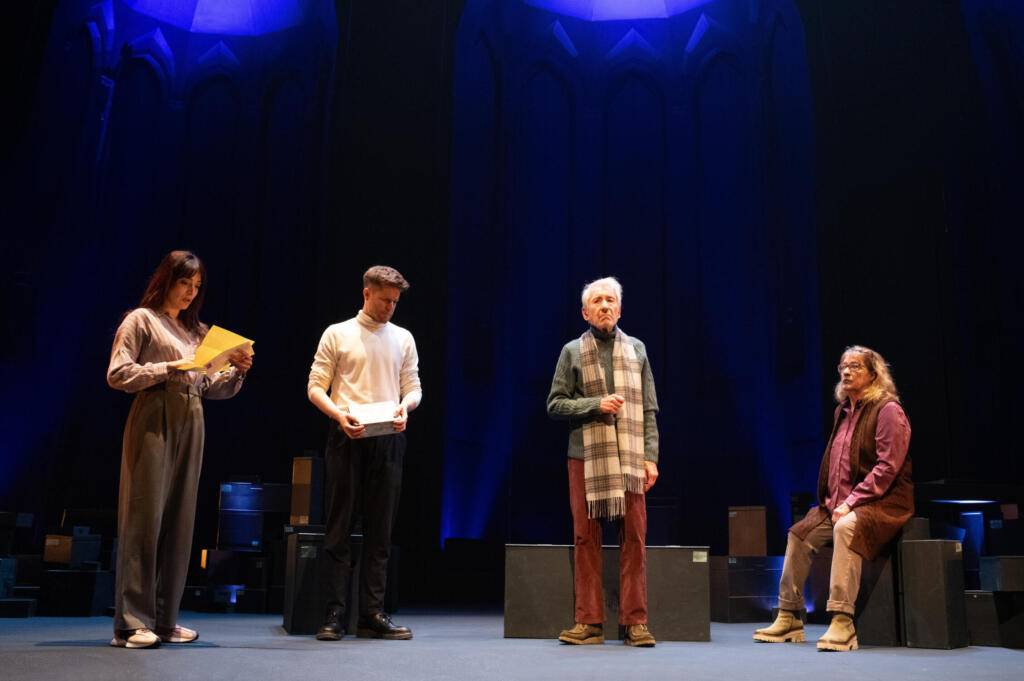
One deal after another as the characters try to outdo each other in Juan Mayorga’s La colección (The Collection): Producción: Lazona | Teatro de La Abadía
Mayorga keeps the dialogue elliptical. The collection is carefully catalogued but items are referred to by number rather than name. The pieces are given agency: Héctor observes that Piece 7 “chose us and then we went after it”. Pieces seduce the buyer. Héctor speaks of the realisation that the couple have been deceived by a piece. “I’m not talking about fakes but about false art, art that lies” he remarks. When Susana opens the boxes at night that hold the history of each piece — a proxy of sorts for the work itself — her face lights up with the light within. This passion for collecting animates her like nothing else.
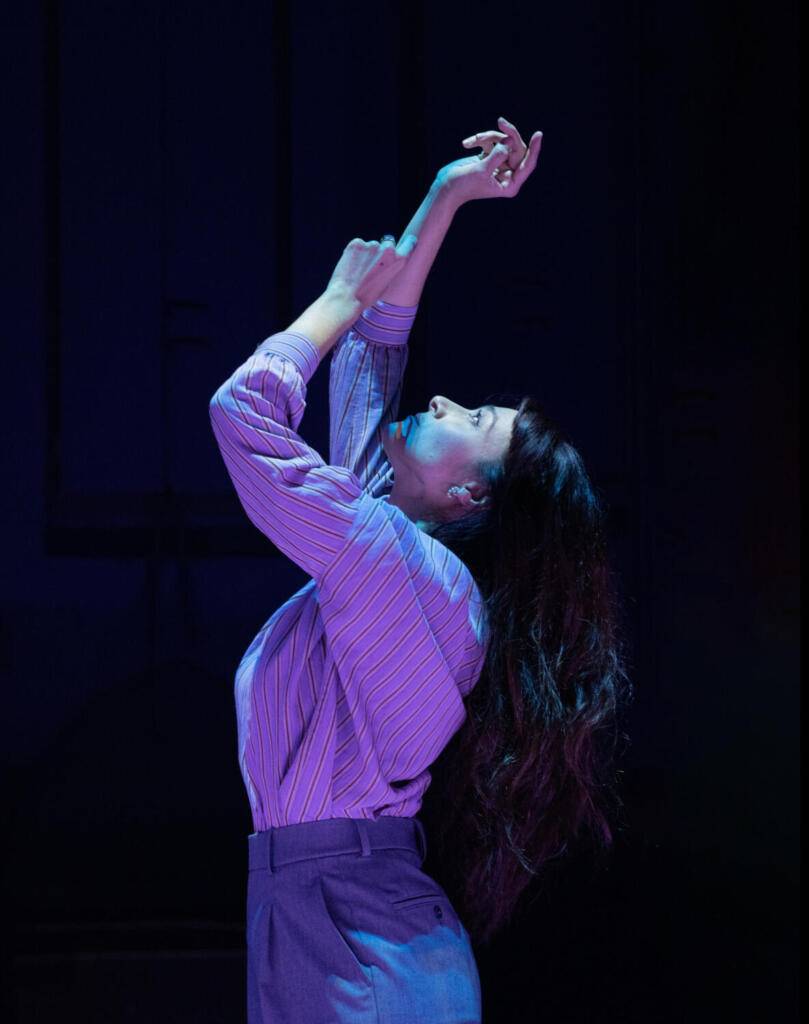
Susana (Zaire Montes) is inspired by the promise of a collection that might be hers n Juan Mayorga’s La colección (The Collection. Production: Lazona | Teatro de La Abadía
As with much of Mayorga’s work, the ways in which language is used (and abused) is central to the play. Susana is fastidious about the Berna’s insistence that Carlos will attend you in all you need”, using the statement as a means of enticing Carlos into acting as her proxy in the sale of a batch of letters she is seeking to acquire. Berna notes the importance of what Susana chooses not to say. Silence speaks louder than words. Berna and Héctor are not adverse to challenging each other. They argue but then make up: Berna resting her head on Héctor’s shoulder or the couple holding hands with a childish quality as they reminisce and plot.
Mayorga opts for a production that plays on awkward silences and misunderstandings. There is a Pinteresque quality to the writing. Carlos has something of the menacing unreadability of Pinter’s loners — Barratt the servant played by Dirk Bogarde in The Servant might be a referent. He opens the piece, closing the shutters as if preparing the space for the performance that is about to begin. There is an inkling of a sexual attraction between him and Susana, or is he just indulging her as she speaks of what the future might hold for him if she inherits the collection and he undertakes the task she asks him to complete. Jaume Manresa creates a soundtrack of lone piano notes that sound like drops of water and an ominous electronic score. Juan Gómez-Cornejo’s lighting — cold blues and warmer yellows — shapes the move from dusk to morning. At the end as the collection is opened up to Carlos and Susana, Mayorga offers a minor theatrical coup that reinforces Borges-like qualities of the writing — especially the subplot of the letters that Susana is seeking to obtain. It’s a delicious twist and one that Mayorga pulls off ambitiously.
Mayorga crafts a Pinteresque play of damaged individuals obsessive in their pursuit of what they desire. It might be a comment on a society of acquisition, on the fact that everything can be bought and sold if the price is right — the conceit at the core of Koltès’ In the Solitude of the Cottonfields. All four characters are contaminated with the collecting bug — even Carlos can’t escape it. José Sacristán’s performance is a delight — playful, lithe, knowing. Ana Marzoa is a pragmatic, no nonsense Berna. Zaira Montes makes Susana a slippery individual. The production is languid and measured, one that the audience is encouraged to savour although I would have liked to see a greater tension between the writing and the staging like that Andrés Lima brought to Mayorga’s The Boy at the Back. That said this is an intriguing work by a writer unafraid of taking his audience on a journey of ambitious ideas and its sell out run shows that Madrid audiences are up for the ride.
La colección plays at Teatro de la Abadía Madrid from 14 March to 21 April.
This post was written by the author in their personal capacity.The opinions expressed in this article are the author’s own and do not reflect the view of The Theatre Times, their staff or collaborators.
This post was written by Maria Delgado.
The views expressed here belong to the author and do not necessarily reflect our views and opinions.

